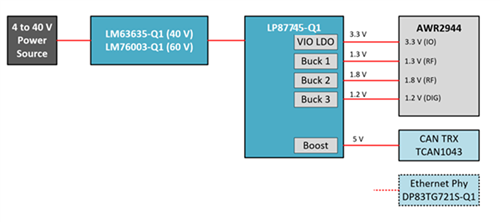SSZTCX3 April 2023 AWR2544 , AWR2944 , LP87745-Q1
Co-authored by Abby Kainer
In the past decade, radar-sensing technology began replacing traditional automotive-sensing modalities given its many advantages – which include long-range detection, higher resolution and increased accuracy – for the implementation of driver safety features, autonomous driving and advanced driver assistance systems.
Radar technology directly measures the distance and radial velocity of oncoming objects in any weather condition, including heavy rain, snow and bright sunlight, thus making it a good technology for meeting New Car Assessment Program requirements. As an effect of the increasing automotive radar market, corner radar technology has quickly evolved.
Corner radars, placed at the two front corners and two rear corners on a vehicle, sense output object data sent over low-bandwidth networks such as Controller Area Network Flexible Data Rate (CAN FD) for the radar to process directly. Corner radars aid in applications such as lane-change and cross-traffic assistance, blind-spot detection, collision avoidance, pedestrian detection, and distance warnings.
Designing a reliable corner radar application can be challenging, however, especially when designing the power supply, since radar sensors typically require specific noise and ripple levels, power capabilities, and thermal dissipation to avoid affecting radio-frequency (RF) performance.
As we see it, there are three power-supply design challenges for corner radar applications:
- The size of the power supply. A physically smaller power supply provides greater power density and efficiency, offering you additional flexibility to add more components to your design. Smart corner radar applications need a smaller solution size given the limited space available in the corners of a vehicle. A smaller power-supply size will also reduce overall system costs while providing the same amount of power.
- The low ripple and noise specifications of radar sensors. Ripple directly impacts the output voltage accuracy and noise level of the power supply, which in turn affects the system’s overall RF. You could use second-stage inductor-capacitor (LC) filters or low-noise low-dropout regulators (LDOs) to help suppress noise spurs and ripple, but these components typically compromise the power supply’s size, temperature and overall cost.
- The temperature of the power supply. As radar power supplies get smaller, the heat generated per unit area increases. High temperatures can compromise the integrity and life span of the power supply. If the radar chip overheats, the speed of its operation can slow down or, in extreme cases, shut down the entire system. For smart corner radars specifically, high temperatures compromise the radar’s ability to measure the distance and radial velocity of oncoming objects.
How a PMIC can help resolve power-supply challenges
Power-management integrated circuits (PMICs) can address the challenge of achieving power density with a reduced solution size and simplified power architecture when compared to a discrete implementation. PMICs that have built-in sequencing can help monitor temperature levels and meet all Automotive Safety Integrity Levels.
One approach is to use a combination of three low-noise buck converters and a 5-V boost converter PMIC for radar monolithic microwave ICs. The LP87745-Q1 is a small-size PMIC designed for radar sensors.
The DC/DC switching of the LP87745-Q1 helps reduce overall cost, reduces noise spurs, lowers ripple amplitude and enables a switching frequency (fsw) of 17.6 MHz, which provides two main benefits:
- You can eliminate the second-stage LC filter on each supply rail. Because the high fsw is greater than radar technology’s intermediate frequency, there is no need for the filters.
- A high fsw creates a lower ripple amplitude and reduces noise spurs, while making it easier to control noise levels.
With the elimination of the external LC filters and LDOs, the LP87745-Q1 will have lower levels of thermal dissipation that will not affect the RF performance of the radar chipset. The temperature levels of the LP87745-Q1 manage the thermal dissipation levels of the power supply, preserving the integrity of the radar chip.
As illustrated in Figure 1, the LP87745-Q1 supports a 5-V rail for CAN-FD-based radar chipsets such as the AWR2944.
 Figure 1 The LP87745-Q1 powering the AWR2944 radar chip for corner radar applications
Figure 1 The LP87745-Q1 powering the AWR2944 radar chip for corner radar applicationsConclusion
It is important to address power-supply challenges in order to have the most efficient radar application, and to protect drivers and passengers. The LP87745-Q1 helps support ASIL C functional safety systems; the elimination of additional voltage monitors helps make it easier to meet functional safety requirements at a system level. The LP87745-Q1’s novel feature set helps solve power-supply design challenges for corner radars, with the potential for use in front, in-cabin and cascaded radar designs.
Additional resources
- Read the technical article, “What ADAS Engineers Need to Know About the New NCAP Requirements for Radar.”
- Download the LP87745-Q1 data sheet.